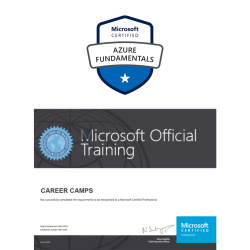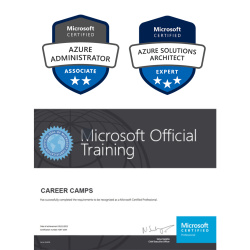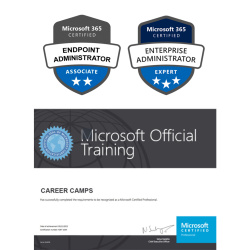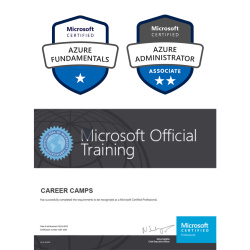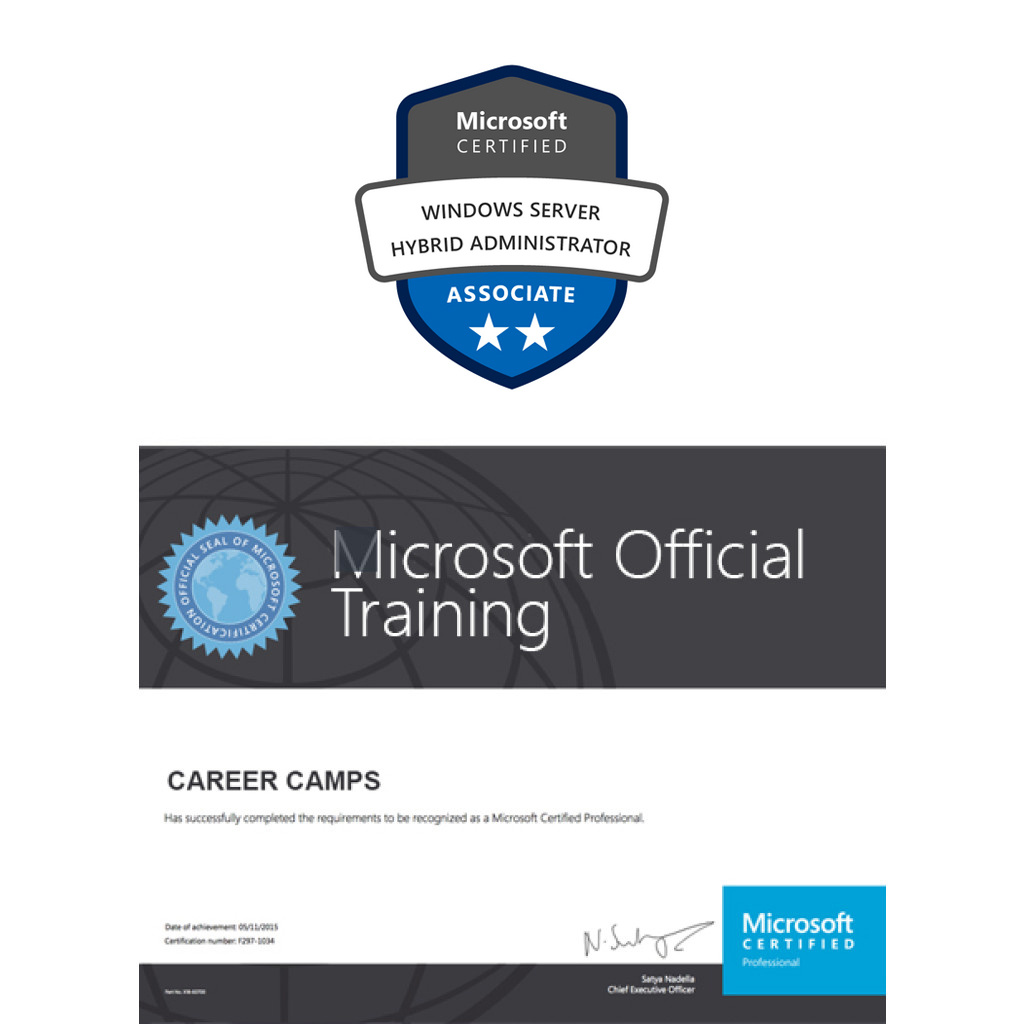
MCA Windows Server Hybrid Administrator Associate Certification Boot Camp – 6 Days (2 Courses, 2 exams, 1 Cert)
$4,495.00
Join this boot camp to become a Microsoft Certified Windows Server Hybrid Administrator. During the course, students will take two exams—AZ-800 (Administering Windows Server Hybrid Core Infrastructure) and AZ-801 (Configuring Windows Server Hybrid Advanced Services)—to earn the MCA Windows Server Hybrid Administrator certification.
This hands-on, instructor-led live training emphasizes the real-world duties of a Windows Server Hybrid Administrator and thoroughly prepares students for the certification exams, which are administered as part of the camp.
Also, check out our MCA Microsoft Azure Administrator Certification Camp and the MCE Microsoft Azure Solutions Architect Certification Camp.
EXAMS INCLUDED
AZ-800: Administering Windows Server Hybrid Core Infrastructure
AZ-801: Configuring Windows Server Hybrid Advanced Services
WHAT IS INCLUDED
| Airfare to/from Sarasota, FL | |
| 6 Nights of Lodging | |
| Ground Transportation | |
| Microsoft Training Books | |
| 2 Microsoft Exam Vouchers | |
| 2 Retake Vouchers (per exam, if needed) | |
| Onsite Pearson Vue Test Center | |
| Microsoft Study Labs & Simulations |
LOCATIONS
Career Camps primary Microsoft Training campus (for individual students) is located in Sarasota, FL. Can’t travel to our facility? No problem! You will save on airfare, lodging and transportation. Just contact us and we will get you pricing to attend the class online live virtually from your work or home. If you do not see the location or class you are looking for, let us know! We have access to hundreds of classes and locations all across the United States and also offer corporate and group rates. If you have 5 or more students we can even come to you! With several partnerships in place, we are sure to have something to fit your needs. Whether you need to get MCA or MCE Certified, or get updated on Microsoft Windows Server 2022, we’ve got you covered.
Description
The Microsoft Certified Windows Server Hybrid Administrator Training & Certification 6-Day Boot Camp is designed for IT professionals who manage both core and advanced Windows Server workloads across on-premises, hybrid, and cloud environments. Students will work with a variety of administrative tools and technologies, including Windows Admin Center, PowerShell, Azure Arc, IaaS virtual machine management, Azure Automation Update Management, Microsoft Defender for Identity, Azure Security Center, Azure Migrate, and Azure Monitor.
During this 6-day, hands-on, instructor-led camp, students will take two certification exams—AZ-800 and AZ-801—to earn the Microsoft Certified: Windows Server Hybrid Administrator Associate credential. The course provides both practical Azure administration experience and full coverage of the content required to pass the certification exams, which are administered during the camp.
The Microsoft Certified Windows Server Hybrid Administrator boot camp is taught using Microsoft Official Courseware –
AZ-800T00: Administering Windows Server Hybrid Core
AZ-801T00: Configuring Windows Server Hybrid Advanced Services
Topics Covered in this Official Boot Camp:
Introduction to AD DS
Describe AD DS.
Describe users, groups, and computers.
Identify and describe AD DS forests and domains.
Describe OUs.
Manage objects and their properties in AD DS
Define AD DS
Define users, groups, and computers
Define AD DS forests and domains
Define OUs
Manage objects and their properties in AD DS
Manage AD DS domain controllers and FSMO roles
Deploy AD DS domain controllers.
Maintain AD DS domain controllers.
Describe the AD DS global catalog role and its placement considerations.
Describe AD DS operations master roles, their placement considerations, and their management tasks.
Describe AD DS schema and its management tasks.
Deploy AD DS domain controllers
Maintain AD DS domain controllers
Manage the AD DS Global Catalog rol
Manage AD DS operations masters
Manage AD DS schema
Implement Group Policy Objects
Describe GPOs.
Describe GPO scope and inheritance.
Describe domain-based GPOs.
Create and configure GPOs.
Explain GPO storage.
Describe administrative templates and the Central Store.
Define GPOs
Implement GPO scope and inheritance
Define domain-based GPOs
Create and configure a domain-based GPO
Define GPO storage
Define administrative templates
Manage advanced features of AD DS
Identify the purpose, types, and the process of creating trust relationships.
Describe the purpose and the process of implementing ESAE forests.
Monitor and troubleshoot AD DS replication.
Identify the purpose and the process of creating custom AD DS partitions.
Create trust relationships
Implement ESAE forests
Monitor and troubleshoot AD DS
Create custom AD DS partitions
Implement hybird identity with Windows Server
Select a Microsoft Entra integration model.
Plan for Microsoft Entra integration.
Prepare on-premises AD DS for directory synchronization.
Install and configure directory synchronization using Microsoft Entra Connect.
Implement Seamless Single Sign-on (SSO).
Enable Microsoft Entra login for an Azure Windows virtual machine (VM).
Describe Microsoft Entra Domain Services.
Implement and configure Microsoft Entra Domain Services.
Manage Windows Server 2019 in a Microsoft Entra Domain Services instance.
Join a Windows Server VM to a managed domain.
Select a Microsoft Entra integration model
Plan for Microsoft Entra integration
Prepare on-premises Active Directory for directory synchronization
Install and configure directory synchronization with Microsoft Entra Connect
Implement Seamless Single Sign-On
Enable Microsoft Entra login in for Windows VM in Azure
Knowledge check 1
Describe Microsoft Entra Domain Services
Implement and configure Microsoft Entra Domain Services
Manage Windows Server 2019 in a Microsoft Entra Domain Services environment
Create and configure a Microsoft Entra Domain Services instance
Join a Windows Server VM to a managed domain
Deploy and manage Azure IaaS Active Directory Domain controllers in Azure
Select an option to implement directory and identity services by using Active Directory Domain Services (AD DS) in Azure.
Deploy and configure AD DS domain controllers in Azure VMs.
Install a replica AD DS domain controller in an Azure VM.
Install a new AD DS forest on an Azure VNet.
Select an option to implement directory and identity services using Active Directory Domain Services in Azure
Deploy and configure Active Directory Domain Services domain controllers in Azure VMs
Install a replica Active Directory domain controller in an Azure VM
Install a new Active Directory forest on an Azure VNet
Perform Windows Server secure administration
Explain least privilege administrative models.
Implement delegated privilege.
Describe privileged access workstations.
Describe jump servers.
Define least privilege administration
Implement delegated privileges
Use privileged access workstations
Use jump servers
Describe Windows Server administration tools
Describe Windows Admin Center.
Describe how to use Remote Server Administration Tools (RSAT) to manage servers.
Describe Server Manager.
Describe how to use Windows PowerShell to manage servers.
Explain how to use Windows PowerShell to remotely administer a server.
Explore Windows Admin Center
Use Server Manager
List Remote Server Administration Tools
Use Windows PowerShell
Use Windows PowerShell to remotely administer a server
Perform post-installation configuration of Windows Server
Explain post-installation configuration and describe the available post-installation configuration tools.
Use Sconfig to configure Windows Server.
Describe Desired State Configuration (DSC) and explain how to use it to configure Windows Server.
Use Windows Admin Center to perform post-installation configuration.
Implement answer files to complete the configuration.
List the available post-installation configuration tools
Configure Server Core using Sconfig
Use DSC to configure Windows Server
Perform post-installation configuration with Windows Admin Center
Configure a server with answer files
Administer and manage Windows Server IaaS Virtual Machine remotely
Select appropriate remote administration tools.
Secure management connections to Windows Azure IaaS VMs with Azure Bastion.
Configure JIT VM access.
Select the appropriate remote administration tool
Manage Windows Virtual Machines with Azure Bastion
Create an Azure Bastion host
Configure just-in-time administration
Manage hybrid workloads with Azure Arc
Describe Azure Arc.
Explain how to onboard on-premises Windows Server instances in Azure Arc.
Connect hybrid machines to Azure from the Azure portal.
Use Azure Arc to manage devices.
Restrict access using RBAC.
Describe Azure Arc
Onboard Windows Server instances
Connect hybrid machines to Azure from the Azure portal
Use Azure Arc to manage Windows Server instances
Restrict access with RBAC
Optimizing IT operations and management with Azure Automanage
Describe how Azure Automanage best practices can optimize the operations of Windows Server and Linux virtual machines.
Explain the different services available through Azure Automanage.
Create and assign a custom configuration profile for Azure Automanage machines.
Describe how to extend Azure Automanage capabilities to non-Azure infrastructure using Azure Arc.
Describe concepts around Azure Automanage best practices
Enable Azure Automanage best practices
Create and assign a custom configuration profile
Extend Azure Automanage across non-Azure infrastructure with Azure Arc
Just Enough Administration in Windows Server
Explain the concept of Just Enough Administration (JEA)
Define role group capabilities and session configurations for a JEA session
Create and connect to a JEA endpoint
Explain the concept of Just Enough Administration (JEA)
Define role capabilities for a JEA endpoint
Create a session configuration file to register a JEA endpoint
Describe how JEA endpoints work to limit access to a PowerShell session
Create and connect to a JEA endpoint
Demonstration: Connect to a JEA endpoint
Configure and manage Hyper-V
Describe the functionality and features of Hyper-V on Windows Server.
Install Hyper-V on Windows Server.
Describe the options for managing Hyper-V virtual machines (VMs) on Windows Server.
Describe networking features and functionality in Hyper-V on Windows Server.
Create virtual switches (vSwitches) for use with Hyper-V.
Describe using nested virtualization in Hyper-V.
Define Hyper-V
Define Hyper-V Manager
Configure Hyper-V hosts using best practices
Configure Hyper-V networking
Assess advanced Hyper-V networking features
Define nested virtualization
Configure and manage Hyper-V virtual machines
Describe settings, configuration, and generation versions available for VMs in Windows Server.
Identify virtual hard disk (VHD) formats and types.
Create and configure a VM.
Determine storage options for VMs.
Describe shared VHDs and VHD Sets.
Describe host and guest clustering with shared VHDs.
List the virtual machine configuration versions
List the virtual machine generation versions
List available VHD formats and types
Create and configure VMs
Determine storage options for VMs
Define shared VHDs and VHD Sets
Implement guest clusters using shared VHDX
Secure Hyper-V workloads
Describe the features and functionality of the HGS in Windows Server.
Describe the attestation options available with the HGS.
Describe shielded VMs, their creation, and their deployment.
Define guarded fabric
Define the Host Guardian Service
Explore TPM-trusted attestation
Define KPS
Determine key features of shielded VMs
Compare encryption-supported and shielded VMs in a guarded fabric
Implement a shielded VM
Plan and deploy Windows Server IaaS Virtual Machines
Describe Azure compute.
Describe Azure storage.
Deploy Azure VMs.
Create a VM from the Azure portal.
Create a VM from Azure Cloud Shell.
Deploy Azure VMs by using templates.
Describe additional management optimization options
Describe Azure compute
Describe Virtual Machine storage
Deploy Azure Virtual Machines
Create a windows Virtual Machine using the portal
Create a windows Virtual Machine using Azure CLI
Deploy Azure Virtual Machines using templates
Describe additional management optimization options
Customize Windows Server IaaS Virtual Machines images
Create a generalized image.
Create a new VM from a generalized image.
Create a managed image of a generalized VM in Azure.
Create a VM from a managed image.
Describe Azure Image Builder.
Use Azure Image Builder to create a Windows image.
Create a generalized image
Create a new Virtual Machine from a managed image
Create a managed image of a generalized virtual machine in Azure
Create a Virtual Machine from a managed image
Implement Azure Image Builder
Create a windows Virtual Machine using Azure Image Builder template
Create a Windows Virtual Machine with Azure Image Builder using PowerShell
Automate the configuration of Windows Server IaaS Virtual Machines
Describe Azure automation.
Implement Azure automation with DSC.
Remediate noncompliant servers.
Describe custom script extension.
Configure a VM by using DSC extensions.
Describe Azure Automation
Implement Azure Automation with DSC
Remediate noncompliant servers
Describe Custom Script Extensions
Configure a Virtual Machine by using DSC
Run Containers on Windows Server
Describe containers and how they work.
Explain the difference between containers and virtual machines (VMs).
Describe the difference between process isolation and Hyper-V isolation modes.
Describe Docker and how it’s used to manage Windows containers.
Identify the container-based images available from the Microsoft Container Registry.
Understand the process for running a Windows container.
Explain how to manage containers using Windows Admin Center (WAC).
Define containers
List the differences between containers and VMs
Define Windows Server and Hyper-V containers and isolation modes
Explore Docker
Prepare a Windows Server 2019 host for container deployment
Security, Storage, and Networking with Windows containers
Orchestrate containers on Windows Server using Kubernetes
Describe container orchestration.
Describe Kubernetes.
Describe how to create a Kubernetes cluster.
Describe Azure Arc for Kubernetes.
Define orchestration
Define Kubernetes
Deploy Kubernetes resources
Create a Kubernetes cluster on Windows
Define Azure Arc
Connect an Azure Arc-enabled Kubernetes cluster to Azure Arc
Implement DNS for Windows Server IaaS VMs
Implement DNS in Azure
Describe DNS options for Azure IaaS VMs
Implement split-horizon DNS in Azure
Troubleshoot DNS in Azure
Create and configure an Azure DNS zone
Understand Azure DNS
Implement Azure DNS
Create an Azure DNS zone and record using the Azure portal
Implement DNS with Azure IaaS virtual machines
Implement split-horizon DNS in Azure
Troubleshoot DNS
Deploy and manage DHCP
Describe the DHCP Server role.
Install and configure the DHCP Server role.
Configure DHCP options.
Create and configure a DHCP scope.
Describe high availability options for DHCP.
Describe DHCP Failover and explain how to configure it.
Use DHCP to simplify IP configuration
Install and configure the DHCP role
Configure DHCP options
Configure DHCP scopes
Select DHCP high availability options
Implement DHCP Failover
Implement Windows Server DNS
Describe Windows Server DNS.
Describe DNS zones and records.
Install and configure the DNS role and DNS zones.
Describe how to implement DNS forwarding.
Explore the DNS architecture
Work with DNS zones and records
Install and configure the DNS role
Implement DNS forwarding
Implement IP Address Management
Describe IPAM.
Deploy IPAM.
Describe how to administer IPAM.
Configure IPAM options.
Manage DNS zones with IPAM.
Manage DHCP servers with IPAM.
Use IPAM to manage IP addressing.
Define IP Address Management
Deploy IP Address Management
Administer IP Address Management
Configure IP Address Management options
Manage DNS zones with IP Address Management
Manage DHCP servers with IP Address Management
Use IP Address Management to manage IP addressing
Implement remote access
Describe the remote access options available in Windows Server.
Select VPN options and set up VPN servers.
Describe the NPS server role.
Plan and implement NPS.
Determine when to deploy PKI for remote access.
Identify the authentication options for Web Application Proxy and explain how to use it to publish applications.
Examine the remote access options in Windows Server
Select and set up VPNs
Use NPS to create and enforce network access policies
Plan and implement NPS
Deploy a PKI for remote access
Use WAP as a reverse web proxy
Implement hybrid network infrastructure
Describe Azure network topologies.
Implement an Azure VPN.
Explain how to create a route-based VPN gateway using the Azure portal.
Implement Azure ExpressRoute.
Implement an Azure WAN.
Implement DNS resolution in hybrid environments.
Describe Azure network topologies
Implement Azure VPN options
Create a route-based VPN gateway using the Azure portal
Implement Azure ExpressRoute
Configure Azure Virtual WAN
Implement DNS in hybrid environments
Implement Windows Server IaaS VM IP addressing and routing
Implement an Azure virtual network
Implement IP Address Allocation in Azure
Assign and manage IP addresses
Configure a private IP address for an Azure virtual machine
Create a virtual machine with a static IP address
Implement IaaS VM IP routing
Implement IPv6 for Windows IaaS Virtual Machines
Implement a virtual network
Implement IaaS VM IP addressing
Assign and manage IP addresses
Configure a private IP address for a virtual machine using the Azure portal
Create a virtual machine with a static public IP address using the Azure portal
Implement IaaS virtual machine IP routing
Implement IPv6 for Windows Server IaaS virtual machines
Manage Windows Server file servers
Describe the Windows Server file system.
Describe the benefits and use of File Server Resource Manager.
Describe SMB and its security considerations.
Manage SMB configuration.
Describe Volume Shadow Copy Service.
Define the Windows Server file system
List the benefits and uses of File Server Resource Manager
Define SMB and its security considerations
Configure SMB protocol
Define Volume Shadow Copy Service
Implement Storage Spaces and Storage Spaces Direct
Describe the architecture and components of Storage Spaces.
Describe the functionality, benefits, and use cases of Storage Spaces.
Implement Storage Spaces.
Describe the functionality, components, and use cases of Storage Spaces Direct.
Implement Storage Spaces Direct.
Define the Storage Spaces architecture and its components
List the functionalities, benefits, and use cases of Storage Spaces
Implement Storage Spaces
List the functionalities, components, benefits, and use cases of Storage Spaces Direct
Implement Storage Spaces Direct
Implement Windows Server Data Deduplication
Describe the architecture, components, and Data Deduplication functionality, components, and use cases of Data Deduplication.
Describe the use cases and interoperability of Data Deduplication.
Implement Data Deduplication.
Manage and maintain Data Deduplication.
Define the architecture, components, and functionality of Data Deduplication
Define the use cases and interoperability of Data Deduplication
Implement Data Deduplication
Manage and maintain Data Deduplication
Implement Windows Server iSCSI
Describe iSCSI functionality, components, and use cases.
Describe the considerations for implementing iSCSI.
Implement iSCSI.
Describe implementing high-availability iSCSI configurations.
List the functionalities, components, and use cases of iSCSI
List the considerations for implementing iSCSI
Implement iSCSI
Configure high availability for iSCSI
Implement Windows Server Storage Replica
Describe the functionality and components of Storage Replica.
Describe the prerequisites for implementing Storage Replica.
Implement Storage Replica.
List the functionalities and components of Storage Replica
Examine the prerequisites for implementing Storage Replica
Implement Storage Replica by using Windows Admin Center
Implement Storage Replica by using Windows PowerShell
Implement a hybrid file server infrastructure
Describe Azure Files.
Configure Azure Files.
Configure connectivity to Azure Files.
Describe Azure File Sync.
Implement Azure File Sync.
Deploy Azure File Sync.
Manage cloud tiering.
Migrate from DFSR to Azure File Sync.
Describe Azure File services
Configure Azure Files
Configure connectivity to Azure Files
Describe Azure File Sync
Implement Azure File Sync
Deploy Azure File Sync
Deploy Azure File Sync 2
Manage cloud tiering
Migrate from DFSR to Azure File Sync
Implement Windows Server IaaS VM network security
Implement Network Security Groups (NSGs) with Windows Server IaaS VMs.
Implement adaptive network hardening.
Implement Azure Firewall.
Implement Windows Defender Firewall in Windows Server IaaS VMs.
Choose an appropriate filtering solution.
Capture network traffic with Network Watcher.
Implement network security groups and Windows IaaS VMs
Implement adaptive network hardening
Implement Azure Firewall and Windows IaaS VMs
Implement Windows firewall with Windows Server IaaS VMs
Choose the appropriate filtering solution
Deploy and configure Azure firewall using the Azure portal
Capture network traffic with network watcher
Log network traffic to and from a VM using the Azure portal
Audit the security of Windows Server IaaS Virtual Machines
Describe Azure Security Center.
Enable Azure Security Center in hybrid environments.
Onboard Windows Server computers to Azure Security Center.
Implement and assess security policies.
Describe Azure Sentinel.
Implement SIEM and SOAR.
Protect your resources with Azure Security Center.
Describe Azure Security Center
Enable Azure Security Center in hybrid environments
Implement and assess security policies
Protect your resources with Azure Security Center
Implement Azure Sentinel
Manage Azure updates
Describe Azure updates.
Enable Update Management.
Deploy updates.
Review an update assessment.
Manage updates for your Azure VMs.
Describe update management
Enable update management
Deploy updates
View update assessments
Manage updates for your Azure Virtual Machines
Create and implement application allowlists with adaptive application control
Enable Adaptive application controls.
Implement adaptive application control policies.
Describe adaptive application control
Implement adaptive application control policies
Configure BitLocker disk encryption for Windows IaaS Virtual Machines
Describe Azure Disk Encryption.
Configure Key Vault to support Azure Disk Encryption.
Explain how to encrypt Azure IaaS VM hard disks.
Back up and recover encrypted data from IaaS VM hard disks.
Describe Azure Disk Encryption and server-side encryption
Configure Key Vault for Azure Disk Encryption
Encrypt Azure IaaS Virtual Machine hard disks
Back up and recover data from encrypted disks
Create and encrypt a Windows Virtual Machine
Implement change tracking and file integrity monitoring for Windows IaaS VMS
Implement Change Tracking and Inventory
Manage Change Tracking and Inventory
Manage tracked files
Implement File Integrity Monitoring
Select and monitor entities
Use File Integrity Monitoring
Implement Change Tracking and Inventory
Manage Change Tracking and Inventory
Manage tracked files
Implement File Integrity Monitoring
Select and monitor entities
Use File Integrity Monitoring
Secure Windows Server DNS
Describe split-horizon DNS and explain how to implement it.
Create DNS policies.
Implement DNS policies.
Describe the options for protecting the DNS server role.
Implement DNS security.
Implement split-horizon DNS
Create DNS policies
Implement DNS policies
Secure Windows Server DNS
Implement DNSSEC
Secure Windows Server user accounts
Configure and manage user accounts to limit security threats across an organization
Apply Protected Users settings, policies, and authentication silos to protect highly privileged user accounts
Describe and configure Windows Defender Credential Guard
Configure Group Policy to block the use of NTLM for authentication
Configure user account rights
Protect user accounts with the Protected Users group
Describe Windows Defender Credential Guard
Block NTLM authentication
Locate problematic accounts
Hardening Windows Server
Manage local administrator passwords using Local Administrator Password Solution
Limit administrative access to Privileged Access Workstations (PAWs)
Explain how to secure domain controllers from being compromised
Describe how to use the Microsoft Security Compliance Toolkit to harden servers
Secure SMB traffic using SMB encryption
Describe Local Password Administrator Solution
Configure Privileged Access Workstations
Secure domain controllers
Analyze security configuration with Security Compliance Toolkit
Secure SMB traffic
Windows Server update management
Describe the role of Windows Server Update Services (WSUS)
Describe the WSUS update management process
Deploy updates with WSUS
Explore Windows Update
Outline Windows Server Update Services server deployment options
Define Windows Server Update Services update management process
Describe the process of Update Management
Introduction to Cluster Shared Volumes
Windows Server 2012 or Windows Server 2016.
Core networking technologies.
Fundamental knowledge of Windows Server Failover Clustering.
Determine the functionality of Cluster Shared Volumes
Explore the architecture and components of Cluster Shared Volumes
Implement Cluster Shared Volumes
Implement Windows Server failover clustering
Describe Windows Server failover clustering.
Implement Windows Server failover clustering.
Manage Windows Server failover clustering.
Implement stretch clusters.
Describe cluster sets.
Define Windows Server failover clustering
Plan Windows Server failover clustering
Implement Windows Server failover clustering
Manage Windows Server failover clustering
Implement stretch clusters
Define cluster sets
Implement high availability of Windows Server VMs
Describe the Hyper-V high availability options.
Describe Hyper-V VMs load balancing.
Implement Hyper-V VMs live migration.
Implement Hyper-V VMs storage migration
Select high-availability options for Hyper-V
Consider network load balancing for Hyper-V VMs
Implement Hyper-V VM live migration
Implement Hyper-V VMs storage migration
Implement Windows Server File Server high availability
Provide a high-level overview of Windows Server File Server high-availability options.
Describe the characteristics of, and high-level implementation steps for Cluster Shared Volumes (CSV).
Describe the characteristics of, and high-level implementation steps for Scale-Out File Server (SOFS).
Describe the characteristics of, and high-level implementation steps for Storage Replica.
Explore the Windows Server File Server high-availability options
Define Cluster Shared Volumes
Implement Scale-Out File Server
Implement Storage Replica
Implement scale and high availability with Windows Server VM
Describe virtual machine scale sets.
Implement scaling.
Implement load-balancing virtual machines.
Implement Azure Site Recovery.
Describe virtual machine scale sets
Implement scaling
Implement load-balancing VMs
Create a virtual machine scale set in the Azure portal
Describe Azure Site Recovery
Implement Azure Site Recovery
Implement Hyper-V Replica
Describe Hyper-V Replica, pre-requisites for its use, and its high-level architecture and components.
Describe Hyper-V Replica usage scenarios, available replication settings, and security considerations.
Configure Hyper-V Replica settings, health monitoring, and failover options.
Implement Hyper-V Replica.
Describe extended replication.
Describe Site Recovery.
Implement Site Recovery.
Define Hyper-V Replica
Plan for Hyper-V Replica
Configure and implement Hyper-V Replica
Define extended replication
Define Azure Site Recovery
Implement Site Recovery from on-premises site to Azure
Implement Site Recovery from on-premises site to on-premises site
Implement hybrid backup and recovery with Windows Server IaaS
Describe Azure Backup.
Implement Recovery Vaults.
Implement Azure Backup policies.
Recover Windows IaaS VMs.
Perform file and folder recovery.
Perform backup and recovery of on-premises workloads.
Explain how to manage Azure VM backups with Azure Backup.
Describe Azure Backup
Implement recovery vaults
Implement Azure Backup policies
Recover Windows IaaS Virtual Machines
Perform file and folder recovery
Perform backup and restore of on-premises workloads
Manage Azure Virtual Machine backups with Azure Backup service
Protect your on-premises infrastructure from disasters with Azure Site Recover
Identify the features and protection capabilities Azure Site Recovery provides to on-premises infrastructure
Identify the requirements for enabling protection of on-premises infrastructure
Azure Site Recovery overview
Workloads supported for protection with Azure Site Recovery
Run a disaster recovery drill
Failover and failback
Protect your Azure infrastructure with Azure Site Recovery
Protect Azure virtual machines with Azure Site Recovery.
Run a disaster recovery drill to validate protection.
Failover and failback your virtual machines.
What is Azure Site Recovery
Prepare for disaster recovery with Azure Site Recovery
Exercise – Set up disaster recovery with Azure Site Recovery
Run a disaster recovery drill
Exercise – Run a disaster recovery drill
Failover and failback using Azure Site Recovery
Protect your virtual machines by using Azure Backup
Identify the scenarios for which Azure Backup provides backup and restore capabilities
Back up and restore an Azure virtual machine
Azure Backup features and scenarios
Back up an Azure virtual machine by using Azure Backup
Exercise – Back up an Azure virtual machine
Restore virtual machine data
Migrate on-premises Windows Server instances to Azure IaaS virtual machines
Plan your migration.
Describe Azure Migrate.
Migrate server workloads using Windows Server Migration Tools.
Assess physical servers with Azure Migrate.
Migrate on-premises servers to Azure.
Plan your migration
Describe Azure Migrate
Perform server assessment
Assess physical servers with Azure Migrate
Migrate Windows Server workloads by using Azure Migrate
Upgrade and migrate Windows Server IaaS virtual machines
Describe Windows Server IaaS migration.
Explain how to migrate workloads using Windows Server Migration tools.
Describe storage migration.
Migrate file servers by using the Storage Migration Service.
Describe Azure Migrate
Migrate Windows Server workloads by using Azure Migrate
Describe storage migration
Migrate file servers by using Storage Migration Service
Active Directory Domain Services migration
Compare upgrading an AD DS forest and migrating to a new AD DS forest
Describe how to upgrade an existing AD DS forest
Describe how to migrate to a new AD DS forest
Describe Active Directory Migration Tool (ADMT)
Examine upgrade vs. migration
Upgrade a previous version of Active Directory Domain Services to Windows Server 2022
Migrate to Active Directory Domain Services in Windows Server 2022 from a previous version
Explore the Active Directory Migration Tool
MIgrate file server workloads using Storage Migration Server
Describe Storage Migration Service and its usage scenarios
Identify the requirements for using Storage Migration Service
Describe how to migrate a server with storage migration
List the considerations for using Storage Migration Service
Storage Migration Service overview and usage scenarios
Storage migration requirements
Migrate a server with Storage migration
Evaluate storage migration considerations
Migrate Windows Server roles
Describe the Windows Server Migration Tools
Use the migration tools to migrate specific Windows Server roles
Describe the Windows Server Migration Tools
Install the Migration Tools
Migrate roles using the Migration Tools
Containerize and migrate ASP.NET applications to Azure App Service
Discover and containerize your ASP.NET app running on Windows machines using Azure Migrate: App Containerization.
Build a container image for your ASP.NET application.
Deploy your containerized application to Azure App Service using Azure Migrate: App Containerization.
Azure Migrate App Containerization overview
Exercise – Set up host environment
Exercise – Discover your ASP.NET web application
Exercise – Build container image for your ASP.NET app
Exercise – Deploy app container to App Service
Monitor Windows Server IaaS Virtual Machines and hybrid instances
Enable Azure Monitor for VMs.
Monitor an Azure VM with Azure Monitor.
Enable Azure Monitor in hybrid scenarios.
Collect data from a Windows computer in a hybrid environment.
Integrate Azure Monitor with Microsoft Operations Manager.
Enable Azure Monitor for Virtual Machines
Monitor an Azure Virtual Machine with Azure Monitor
Enable Azure Monitor in hybrid scenarios
Collect data from a Windows computer in a hybrid environment
Integrate Azure Monitor with Microsoft Operations Manager
Monitor your Azure virtual machines with Azure Monitor
Understand which monitoring data you need to collect from your VM.
Enable and view recommended alerts and diagnostics.
Use Azure Monitor to collect and analyze VM host metrics data.
Use Azure Monitor Agent to collect VM client performance metrics and event logs.
Monitoring for Azure VMs
Monitor VM host data
Use Metrics Explorer to view detailed host metrics
Collect client performance counters by using VM insights
Collect VM client event logs
Monitor Windows Server performance
Use built-in tools in Windows Server to monitor server performance
Understand the fundamentals of server performance tuning
Use Performance Monitor to identify performance problems
Use Resource Monitor to review current resource usage
Review reliability with Reliability Monitor
Implement a performance monitoring methodology
Use Data Collector Sets to analyze server performance
Monitor network infrastructure services
Monitor virtual machines running Windows Server
Monitor performance with Windows Admin Center
Use System Insights to help predict future capacity issues
Optimize the performance of Windows Server
Manage and monitor Windows Server event logs
Describe event logs
Use Server Manager and Windows Admin Center to – Review event logs
Implement custom views
Configure an event subscription
Describe Windows Server event logs
Use Windows Admin Center to review logs
Use Server Manager to review logs
Use custom views
Implement event log subscriptions
Implement Windows Server auditing and diagnostics
Audit Windows Server events
Configure Windows Server to record diagnostic information
Describe basic auditing categories
Describe advanced categories
Log user access
Enable setup and boot event collection
Troubleshoot on-premises and hybrid networking
Diagnose DHCP and DNS problems in on-premises contexts.
Diagnose IP configuration and routing problems.
Implement Packet Monitor to help diagnose network problems.
Use Azure Network Watcher to troubleshoot Microsoft Azure virtual networks.
Diagnose DHCP problems
Diagnose DNS problems
Diagnose IP configuration issues
Diagnose routing problems
Use Packet Monitor to help diagnose network problems
Use Azure Network Watcher to help diagnose network problems
Troubleshoot Windows Server Virtual Machines in Azure
Troubleshoot VM deployment and extension issues
Troubleshoot VM startup and performance issues
Troubleshoot VM storage and encryption issues
Troubleshoot connectivity to VMs
Troubleshoot VM deployment
Troubleshoot VM startup
Troubleshoot VM extensions
Troubleshoot VM connectivity
Troubleshoot VM performance
Troubleshoot VM storage
Troubleshoot Active Directory
Recover the AD DS database, objects in AD DS, and SYSVOL
Troubleshoot AD DS replication
Troubleshoot Hybrid authentication issues
Recover objects from the AD recycle bin
Recover the AD DS database
Recover SYSVOL
Troubleshoot AD DS replication
Troubleshoot hybrid authentication issues
Additional information
| Class Dates | 12/15/2025 – 12/20/2025 – Sarasota, FL, 01/19/2026 – 01/24/2026 – Sarasota, FL, 02/16/2026 – 02/21/2026 – Sarasota, FL, 03/23/2026 – 03/28/2026 – Sarasota, FL, 04/20/2026 – 04/25/2026 – Sarasota, FL, 05/11/2026 – 05/16/2026 – Sarasota, FL, 06/01/2026 – 06/06/2026 – Sarasota, FL |
|---|
Our Facilities
CAREER CAMPS FACILITIES

CLASSROOM EQUIPMENT – Students work on a dedicated Dell Client Desktop with 32GB memory with 512GB SSD drives – All Labs are executed the extremely fast Microsoft Data Center Hosted Lab Environment.
CAMPUS INTERNET – The campus is connected with a 1Gbps (1,000 Mbps) Verizon Fios Business Connection which provides complete internet (including VPN) access for students.
COMMON AREA – Amenities including snacks, drinks (Coffee, 100% juices, sodas, etc) all complimentary.
LODGING – We use the Hyatt Place Lakewood Ranch. This “upgraded” hotel offers extremely comfortable beds, great breakfast and very fast internet access.
NEAR BY AMENITIES – Many shops, restaurants and grocery options are available within walking distance. Additionally – the hotel provided scheduled shuttle services. Restaurants like Bone Fish Grill, Ruby Tuesday’s, Five Guys, Chipotle, Quiznos, Chili’s and over 20 additional choices in the immediate area. All of these options are offered in a pedestrian walking village.
Why Choose Us
CAREER CAMPS DIFFERENCE
Career Camps provides an in-depth hands on learning environment. Our instructors teach using demonstrations and explain concepts beyond the scope of the courseware. The best instructors are contracted from all across the US. These professionals are real world consultants who actually implement these technologies. Career Camps knows our clients work in the “real world” and it only makes sense to have an instructor with the experience in the real world.
Facilities – Many of our competitors over-crowd classrooms by placing 2 to 3 students per desk and 20+ students per instructor. Often these companies “extend” the life of very old equipment with slow performance on the software used today. Our average class size is 8 students. Our facilities have the best equipment with the most comfortable, focused environment for learning.
Instructors – Our CEO, Chester Flake holds one of the rarest Microsoft Certifications – the Microsoft Certified Learning Consultant (MCLC) Certification. This certification reflects a commitment to make sure our instructors are also actively engaged in real world consulting projects. Students expect a professional who can answer questions and demonstrate the technology.
Face to Face Training – We believe the best way to interact and learn is face to face training. Many of our competitors which offer local training are simply providing students with headphones/mic to attend class with an instructor at a remote location.
Test Pass – We offer a free retake voucher (if needed) for each of the exams required for certification. Any training center offering a “100% pass guarantee” would have to use unethical practices or unlimited test vouchers (which is not likely or practical).
Distractions – Students often look for a “local” training center so they can be close to home and work. Boot camp requires a tremendous time commitment during the program. Long class hours combined with self study each evening. The goal of boot camp is to achieve certification in a fraction of the time. We strongly recommend students attend camp away from home and work in a focused, distraction free environment.
Boot Camp – Boot camp is an accelerated training focused on teaching technology and testing students on the official exams. Most training providers “added” boot camps to the existing standard training classes they offer. These training centers think a boot camp is just a regular class where you send the student home with a voucher on the last day. Career Camps administers exams throughout the camp. Equally important – not every trainer can teach a boot camp and not all courseware is designed for boot camp format. Our trainers know the boot camp format and our courseware is designed for accelerated learning.
Florida – Career Camps has one of the most scenic locations boasting some of the best weather in US. We believe students should have a comfortable and inviting atmosphere while attending these otherwise intense programs. We place our location, facilities and amenities up against that any competitor.
You May Also Like:
Related products
-
Azure Fundamentals Certification Camp (1 Course, 1 Exam, 1 Cert)
$995.00 Select options This product has multiple variants. The options may be chosen on the product page -
MCA Microsoft Azure Admin + MCE Solutions Architect Accelerated COMBO Certification Camp (2 Courses, 2 Exams, 2 Certs)
$4,995.00 Select options This product has multiple variants. The options may be chosen on the product page -
MCE Microsoft 365 Administrator Expert w/MCA Microsoft 365 Endpoint Administrator Accelerated COMBO Certification Camp (2 Courses, 2 Exams, 2 Certs)
$4,995.00 Select options This product has multiple variants. The options may be chosen on the product page -
MCA Microsoft Azure Admin (w/ Azure Foundations) Certification Camp (2 Courses, 2 Exams, 2 Certs)
$4,495.00 Select options This product has multiple variants. The options may be chosen on the product page

